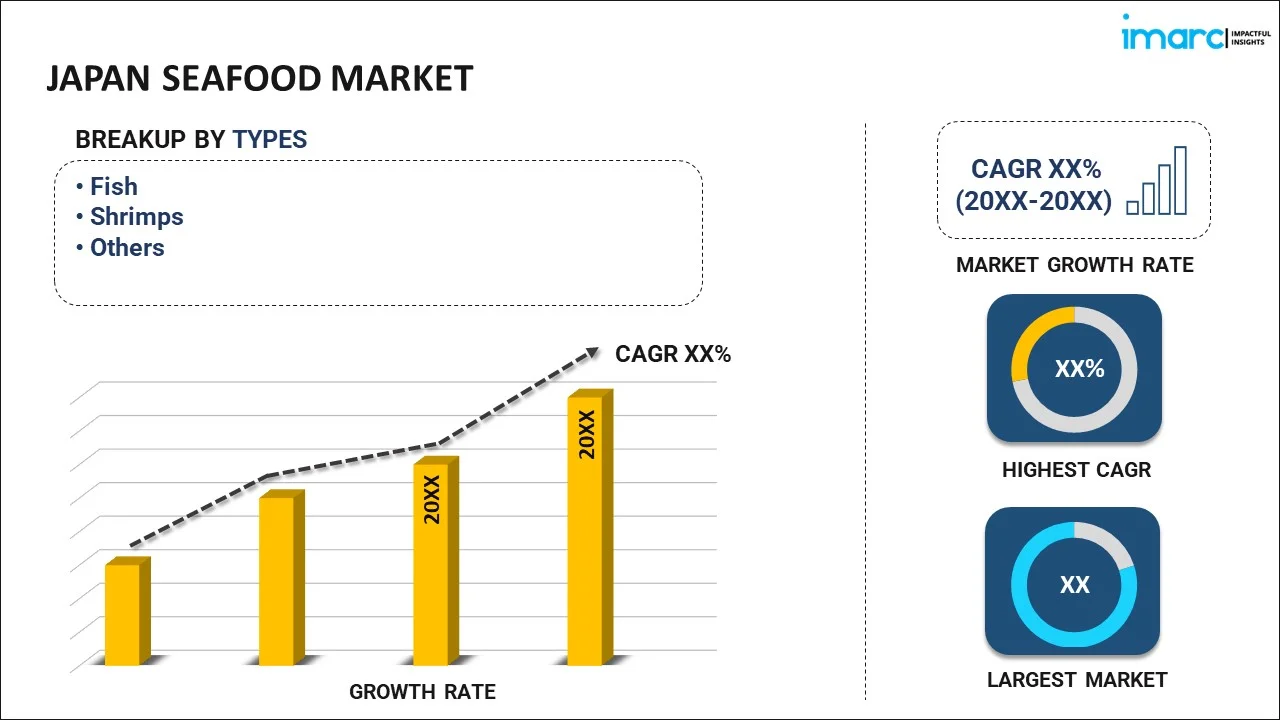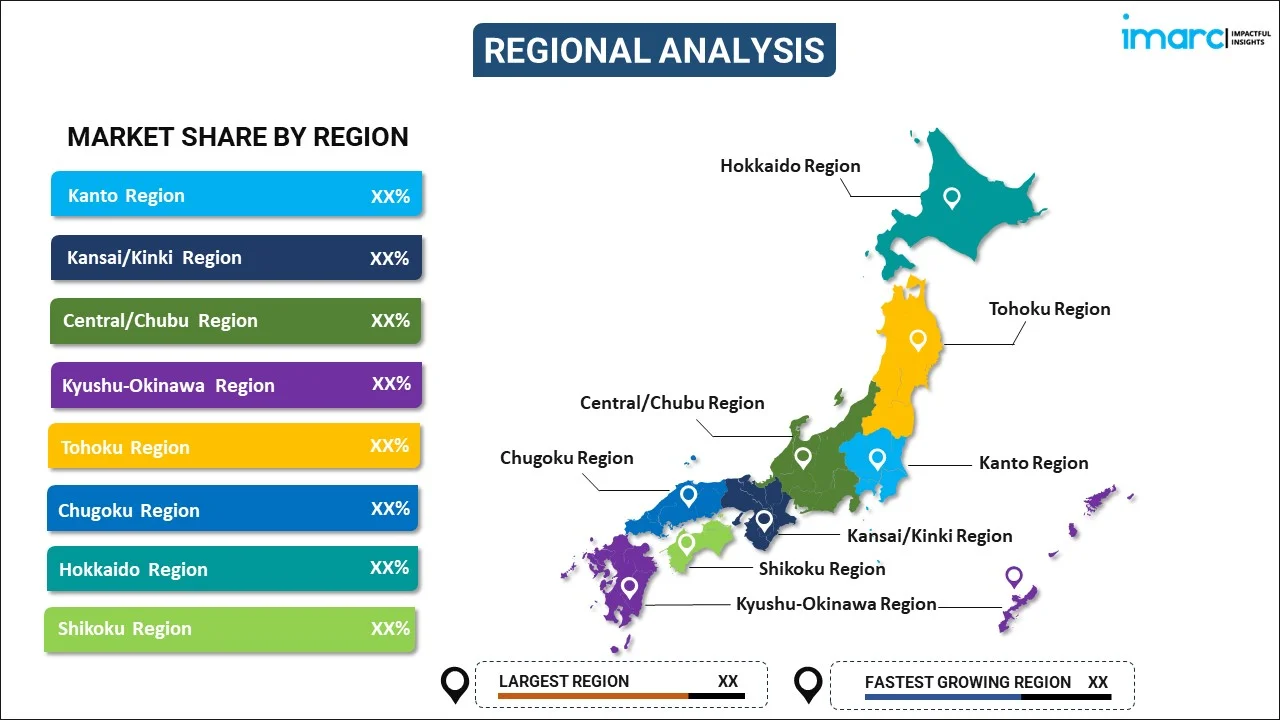
Japan Seafood Market Report by Type (Fish, Shrimps, and Others), Form (Fresh/Chilled, Frozen/Canned, Processed), Distribution Channel (Off Trade, On Trade), and Region 2025-2033
Market Overview:
The Japan seafood market size reached USD 21.9 Billion in 2024. Looking forward, IMARC Group expects the market to reach USD 26.0 Billion by 2033, exhibiting a growth rate (CAGR) of 1.9% during 2025-2033. The country’s rich culinary tradition, ongoing technological advancements in sustainable fishing and aquaculture, and rising demand for premium and sustainably sourced seafood among health-conscious and quality-focused consumers represent some of the key factors driving the market.
|
Report Attribute
|
Key Statistics
|
|---|---|
|
Base Year
|
2024 |
|
Forecast Years
|
2025-2033
|
|
Historical Years
|
2019-2024
|
| Market Size in 2024 | USD 21.9 Billion |
| Market Forecast in 2033 | USD 26.0 Billion |
| Market Growth Rate (2025-2033) | 1.9% |
Seafood encompasses a diverse range of aquatic organisms widely recognized for their nutritional value and culinary versatility. It is mainly sourced from oceans, seas, rivers, and lakes and typically includes fish, crustaceans, mollusks, and other marine creatures. Fish, a major category, comprises species like salmon, tuna, and cod, valued for their high protein and omega-3 fatty acid content. Crustaceans, including shrimp, crabs, and lobsters, are favored for their rich, distinct flavors. Mollusks, such as oysters, clams, and mussels, are known for their unique textures and taste profiles. Globally, seafood plays a crucial role in diets, offering a healthier protein alternative to red and processed meats. It is renowned for its rich nutritional benefits, including essential vitamins (like Vitamin D and B12), minerals (like iodine and selenium), and omega-3 fatty acids, crucial for heart health and cognitive function. The versatility of seafood in culinary practices is notable, with varying preparation methods like grilling, frying, steaming, and baking, allowing it to feature prominently in diverse cuisines worldwide. Sustainable seafood sourcing is increasingly emphasized, addressing overfishing and environmental impacts. Practices like aquaculture (fish farming) are gaining immense traction, offering a sustainable alternative to wild-caught seafood. This shift is vital for preserving marine ecosystems and ensuring long-term seafood availability. As a result, seafood represents a vital and sustainable food source, integral to various dietary patterns and culinary traditions across Japan and the world.
Japan Seafood Market Trends:
The Japan seafood market is propelled by a confluence of cultural, economic, and technological factors, reflecting its deep-rooted significance in Japanese cuisine and the broader food industry. Japan, with its extensive coastline and historical reliance on marine resources, has a longstanding tradition of seafood consumption. This tradition, integrated into daily diets and culinary practices, creates a consistent demand for a variety of seafood products. Moreover, the cultural importance of seafood in Japanese cuisine represents another major factor fueling the market growth. Sushi and sashimi, which are globally recognized Japanese dishes, heavily rely on fresh, high-quality fish and shellfish. The rising popularity of these dishes, both within Japan and internationally, sustains a robust market for seafood, further driving growth. Additionally, seasonal and regional specialties, reflecting the country’s diverse maritime ecosystem, contribute to a broad consumer palate eager to explore different seafood varieties. In line with this, Japan’s developed economy, high standard of living, and an expanding health-conscious population are augmenting the demand for premium quality and sustainably sourced seafood, thus supporting market growth. Besides this, the increasing consumer willingness to pay a premium for superior quality, traceability, and sustainability is positively influencing market growth. Furthermore, ongoing technological advancements in fishing, aquaculture, and preservation methods are contributing to the market growth. For instance, innovations in aquaculture aimed at sustainable and efficient production meet the escalating demand for seafood while addressing environmental concerns. Along with this, the development of novel techniques like improved refrigeration and rapid transportation systems that ensure fresh seafood delivery, both domestically and for export, is fostering market growth. Moreover, supportive government policies and international trade agreements are accelerating the market growth. Japan’s efforts to secure sustainable fishing practices and its involvement in international agreements impact seafood supply chains. These policies ensure a balance between meeting consumer demand and preserving marine ecosystems, thus catalyzing market growth. Apart from this, the rise of e-commerce and online delivery platforms has expanded market accessibility, allowing consumers to purchase a variety of seafood products conveniently. This digital shift caters to changing consumer behaviors and broadens the product reach, thereby providing a positive thrust to market growth.
Japan Seafood Market Segmentation:
IMARC Group provides an analysis of the key trends in each segment of the market, along with forecasts at the country level for 2025-2033. Our report has categorized the market based on type, form, and distribution channel.
Type Insights:

- Fish
- Shrimps
- Others
The report has provided a detailed breakup and analysis of the market based on the type. This includes fish, shrimps, and others.
Form Insights:
- Fresh/Chilled
- Frozen/Canned
- Fresh/Chilled
A detailed breakup and analysis of the market based on the form have also been provided in the report. This includes fresh/chilled, frozen/canned, and processed.
Distribution Channel Insights:
- Off Trade
- On Trade
The report has provided a detailed breakup and analysis of the market based on the distribution channel. This includes off trade and on trade.
Regional Insights:

- Kanto Region
- Kansai/Kinki Region
- Central/ Chubu Region
- Kyushu-Okinawa Region
- Tohoku Region
- Chugoku Region
- Hokkaido Region
- Shikoku Region
The report has also provided a comprehensive analysis of all the major regional markets, which include Kanto Region, Kansai/Kinki Region, Central/ Chubu Region, Kyushu-Okinawa Region, Tohoku Region, Chugoku Region, Hokkaido Region, and Shikoku Region.
Competitive Landscape:
The market research report has also provided a comprehensive analysis of the competitive landscape. Competitive analysis such as market structure, key player positioning, top winning strategies, competitive dashboard, and company evaluation quadrant has been covered in the report. Also, detailed profiles of all major companies have been provided.
Japan Seafood Market Report Coverage:
| Report Features | Details |
|---|---|
| Base Year of the Analysis | 2024 |
| Historical Period | 2019-2024 |
| Forecast Period | 2025-2033 |
| Units | Billion USD |
| Scope of the Report | Exploration of Historical and Forecast Trends, Industry Catalysts and Challenges, Segment-Wise Historical and Predictive Market Assessment:
|
| Types Covered | Fish, Shrimps, Others |
| Forms Covered | Fresh/Chilled, Frozen/Canned, Processed |
| Distribution Channels Covered | Off Trade, On Trade |
| Regions Covered | Kanto Region, Kansai/Kinki Region, Central/ Chubu Region, Kyushu-Okinawa Region, Tohoku Region, Chugoku Region, Hokkaido Region, Shikoku Region |
| Customization Scope | 10% Free Customization |
| Post-Sale Analyst Support | 10-12 Weeks |
| Delivery Format | PDF and Excel through Email (We can also provide the editable version of the report in PPT/Word format on special request) |
Key Questions Answered in This Report:
- How has the Japan seafood market performed so far and how will it perform in the coming years?
- What has been the impact of COVID-19 on the Japan seafood market?
- What is the breakup of the Japan seafood market on the basis of type?
- What is the breakup of the Japan seafood market on the basis of form?
- What is the breakup of the Japan seafood market on the basis of distribution channel?
- What are the various stages in the value chain of the Japan seafood market?
- What are the key driving factors and challenges in the Japan seafood?
- What is the structure of the Japan seafood market and who are the key players?
- What is the degree of competition in the Japan seafood market?
Key Benefits for Stakeholders:
- IMARC’s industry report offers a comprehensive quantitative analysis of various market segments, historical and current market trends, market forecasts, and dynamics of the Japan seafood market from 2019-2033.
- The research report provides the latest information on the market drivers, challenges, and opportunities in the Japan seafood market.
- Porter's five forces analysis assist stakeholders in assessing the impact of new entrants, competitive rivalry, supplier power, buyer power, and the threat of substitution. It helps stakeholders to analyze the level of competition within the Japan seafood industry and its attractiveness.
- Competitive landscape allows stakeholders to understand their competitive environment and provides an insight into the current positions of key players in the market.
Need more help?
- Speak to our experienced analysts for insights on the current market scenarios.
- Include additional segments and countries to customize the report as per your requirement.
- Gain an unparalleled competitive advantage in your domain by understanding how to utilize the report and positively impacting your operations and revenue.
- For further assistance, please connect with our analysts.
 Inquire Before Buying
Inquire Before Buying
 Speak to an Analyst
Speak to an Analyst
 Request Brochure
Request Brochure
 Request Customization
Request Customization




.webp)




.webp)












